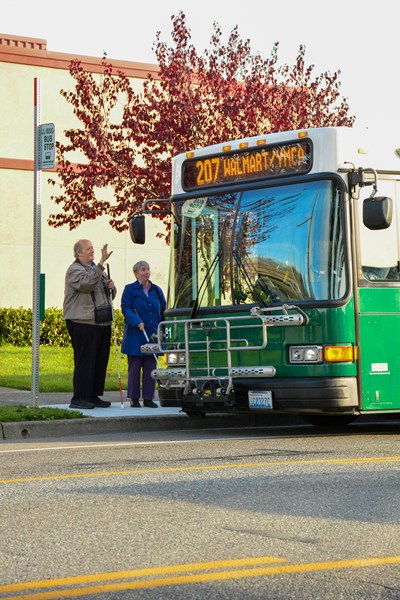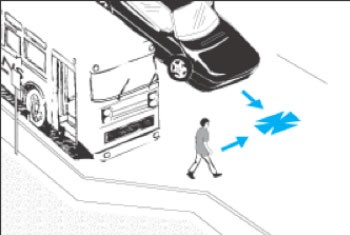Skagit Transit does not have the legal authority to place bus stops anywhere we would like. The agency must seek permission via a permit from the jurisdiction with legal control of traffic engineering, usually either a municipality or Skagit County. Bus stops must take into account a variety of factors including, but not limited to, land use, traffic flow, traffic speed limits, and the presence of driveways among other factors.

Determining the optimal spacing for bus stops is a crucial aspect of public transit planning. Skagit Transit must balance the need for convenience with operational efficiency. Ideally, bus stops should be neither too close together, which could cause unnecessary delays in service, nor too far apart, which might result in long walks for passengers to and from the stops.
In urban areas like the cities and towns within Skagit County, the recommended distance between bus stops typically ranges from 600 to 800 feet, approximately equivalent to 2 to 4 city blocks. This spacing can be adjusted based on specific local needs, such as to accommodate significant destinations or to overcome physical constraints. For example, in rural parts of the county, stops might be more spread out, reflecting lower demand or geographical challenges like the absence of sidewalks, the presence of natural barriers, or insufficient right-of-way.
Each bus stop location is selected after careful consideration of several factors including land use patterns, pedestrian pathways, and traffic conditions to ensure that the service is both accessible and efficient for the community.
Bus stops are located along a street in one of 3 positions: near side, far side, or mid-block. This position is determined by the location of any cross street. Each position has certain positive and negative characteristics. The exact placement will depend on the presence of certain characteristics such as stop lights, pedestrian crossings, and other physical elements of a location. For instance, if an intersection has a stop light, then the bus stop may be placed on the far side so that the bus can clear the traffic signal before stopping. If the bus has to stop before the traffic signal (aka near side), then the bus has a greater chance of being delayed by a red light.

Strategically placed bus stops enhance accessibility and promote increased ridership by aligning with the land use patterns of an area. For example, positioning bus stops close to high-traffic destinations like hospitals or shopping centers in Mount Vernon capitalizes on the daily flow of people to these sites. Ensuring there are clear, safe pedestrian pathways connecting bus stops to these local hubs is a priority, as it enables seamless travel for passengers from their initial boarding to their final destination.

Skagit Transit places great emphasis on strategic planning for bus stop locations, prioritizing pedestrian safety and efficient traffic flow. The optimal scenario places bus stops just beyond pedestrian crossings, a practice which tends to reduce bus delays that may occur when passengers cross in front of the bus upon exiting. This careful placement also enhances pedestrian safety. When passengers disembark and cross behind the bus, they have a clear, unobstructed view of oncoming vehicles, greatly reducing the risk of accidents. Furthermore, such positioning aids in the smooth coordination between pedestrian traffic signals and bus movement, facilitating a safer and more predictable journey for all.
Skagit Transit is committed to enhancing the passenger experience at our bus stops with practical and comfortable amenities. Our shelters are configured to seat two passengers and have additional space for mobility devices, while providing a weather-protective three-sided enclosure with a roof. We offer shelters in two sizes: the full-sized model and the cantilever model, which features shorter side walls for use in smaller spaces without sacrificing roof coverage or seating capacity.
The full-sized shelters measure 5 feet by 10 feet, and cantilever shelters are 3 feet by 10 feet. Each shelter is supported by a concrete pad that is 6 inches larger on each side to ensure a secure installation.
Where space is limited and a traditional bench is not feasible, Skagit Transit deploys Simme-Seats, a compact and efficient seating solution that integrates a bus stop sign pole. Renowned for their ease of installation and low maintenance, Simme-Seats provide a convenient seating option while conserving space.
A concrete pad of 2 feet by 4 feet is required for the installation of Simme-Seats, offering a solid and durable seating arrangement for our passengers.
Compliance with ADA standards is paramount in the design and layout of bus stops to ensure accessibility for all. ADA guidelines stipulate that bus stops must be at least 5 feet wide and 8 feet deep, featuring a hardened surface to accommodate mobility devices. Additionally, each bus stop should include a 5-foot wide connection to an existing pedestrian pathway, facilitating safe and easy access for individuals with disabilities.
Proper lighting at bus stops is crucial for safety and accessibility. Well-lit bus stops deter criminal activities and ensure that bus operators can easily see waiting passengers, especially during nighttime. Skagit Transit prioritizes the installation of adequate lighting at all bus stops to create a secure environment for passengers. While new bus shelters are equipped with lighting solutions, we are also focused on enhancing existing structures to improve visibility and safety for our users.